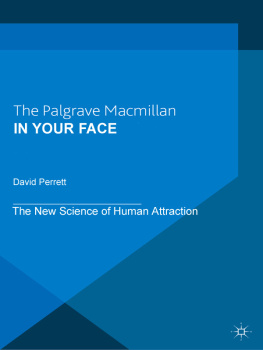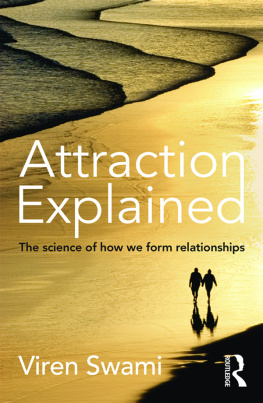David Perrett - In Your Face: The New Science of Human Attraction
Here you can read online David Perrett - In Your Face: The New Science of Human Attraction full text of the book (entire story) in english for free. Download pdf and epub, get meaning, cover and reviews about this ebook. year: 2010, publisher: The Palgrave Macmillan, genre: Religion. Description of the work, (preface) as well as reviews are available. Best literature library LitArk.com created for fans of good reading and offers a wide selection of genres:
Romance novel
Science fiction
Adventure
Detective
Science
History
Home and family
Prose
Art
Politics
Computer
Non-fiction
Religion
Business
Children
Humor
Choose a favorite category and find really read worthwhile books. Enjoy immersion in the world of imagination, feel the emotions of the characters or learn something new for yourself, make an fascinating discovery.
- Book:In Your Face: The New Science of Human Attraction
- Author:
- Publisher:The Palgrave Macmillan
- Genre:
- Year:2010
- Rating:4 / 5
- Favourites:Add to favourites
- Your mark:
- 80
- 1
- 2
- 3
- 4
- 5
In Your Face: The New Science of Human Attraction: summary, description and annotation
We offer to read an annotation, description, summary or preface (depends on what the author of the book "In Your Face: The New Science of Human Attraction" wrote himself). If you haven't found the necessary information about the book — write in the comments, we will try to find it.
In Your Face: The New Science of Human Attraction — read online for free the complete book (whole text) full work
Below is the text of the book, divided by pages. System saving the place of the last page read, allows you to conveniently read the book "In Your Face: The New Science of Human Attraction" online for free, without having to search again every time where you left off. Put a bookmark, and you can go to the page where you finished reading at any time.
Font size:
Interval:
Bookmark:
IN YOUR FACE
The New Science of Human Attraction
David Perrett


David Perrett 2010
All rights reserved. No reproduction, copy or transmission of this publication may be made without written permission.
No portion of this publication may be reproduced, copied or transmitted save with written permission or in accordance with the provisions of the Copyright, Designs and Patents Act 1988, or under the terms of any licence permitting limited copying issued by the Copyright Licensing Agency, Saffron House, 610 Kirby Street, London EC1N 8TS.
Any person who does any unauthorized act in relation to this publication may be liable to criminal prosecution and civil claims for damages.
The author has asserted his right to be identified as the author of this work in accordance with the Copyright, Designs and Patents Act 1988.
First published 2010 by
PALGRAVE MACMILLAN
Palgrave Macmillan in the UK is an imprint of Macmillan Publishers Limited, registered in England, company number 785998, of Houndmills, Basingstoke, Hampshire RG21 6XS.
Palgrave Macmillan in the US is a division of St Martins Press LLC, 175 Fifth Avenue, New York, NY 10010.
Palgrave Macmillan is the global academic imprint of the above companies and has companies and representatives throughout the world.
Palgrave and Macmillan are registered trademarks in the United States, the United Kingdom, Europe and other countries.
ISBN 9780230201293
This book is printed on paper suitable for recycling and made from fully managed and sustained forest sources. Logging, pulping and manufacturing processes are expected to conform to the environmental regulations of the country of origin.
A catalogue record for this book is available from the British Library.
A catalog record for this book is available from the Library of Congress.
10 9 8 7 6 5 4 3 2 1
19 18 17 16 15 14 13 12 11 10
Printed in China
Figures
Plates
I thank Louise Barrett, who shaped the entire work, who did so much with the first few drafts, and who was there for almost all of the adventure; Anne Perrett, who watched over each sentence and argument, and who has lived and breathed faces our whole life together; Tamsin Saxton, whose care clarified so much of the book; Monika Harvey, whose apt opinions improved the logic; Beatriz Martin-Andrade, who kept the story line from being too wide of the mark; Jaime Marshall, my editor at Palgrave Macmillan, whose belief and coaxing sustained the project; Andrew Nash, whose thorough line editing transformed the text into a readable form; the many people, including Vinet Coetzee, Lisa DeBruine, Juan Carlos Gomez, Ben Jones, Ferenc Kocsor, Jennifer Lewis, Tony Little, David Milner, Marisa Parker, Daniel Re, Ian Stephen, and Ross Whitehead, who checked the text, giving praise when they felt it was merited, yet pointing also to places where the text was inadequate, flippant, patronizing, depressing, or soppy; Davis Buls, for some splendid artwork; Bernard Tiddeman, for the powerful computer graphics; and all those colleagues whose work in the Perception Lab at the University of St Andrews created the stuff to write about, including Lesley Ferrier who patiently organized us all.
DAVID PERRETT
The Perception Lab is based at the School of Psychology, University of St Andrews, Scotland (http://perception.st-and.ac.uk/).
. Creative Commons [accessed 2010]. |
. Creative Commons [accessed 15/11/09]. |
.) |
[accessed 01/09/09] (Reproduced with permission: Macmillan Publishers Ltd.) . Creative Commons [accessed 18/11/09]. . Creative Commons [accessed 18/11/09]. . Creative Commons [accessed 18/11/09]. . Creative Commons [accessed 18/11/09]. |
[accessed 24/11/09]. . Creative Commons [accessed 24/11/09]. .jpg. Creative Commons [accessed 24/11/09]. . Creative Commons [accessed 24/11/09]. [accessed 24/11/09]. . Creative Commons [accessed 24/11/09]. |
[accessed 20/10/09]. |
. Creative Commons [accessed 20/9/09]. |
evaluation. In Proceedings of the 22nd IFSCC Conference, pp. 317323. Edinburgh, Scotland, September 2002. (Images courtesy of Unilever Research.) |
[accessed 10/12/09]. |
Colour plates
. |
. |
. |
. |
. |
. |
. |
. |
. |
. |
. |
. |
. |
. |
This book is for anyone who is curious about beauty. Its purpose is to explain, from a scientific point of view, our attraction to faces an attraction that has driven the evolution of our species for millions of years, but that has only recently begun to give up its secrets to scientific study.
While we can normally agree on who has an attractive face, one of my central motivations in writing this book was to bring together the scientific results that demonstrate the diversity in attraction, that is, the reasons why different people find different faces attractive. While the work in my lab at the University of St Andrews, in Scotland, has produced some general rules of attractive faces, it didnt take long for results to emerge that showed that not everyone plays by the same rules or focuses on the same cues when deciding who has an attractive face. Facial attraction is personal and as we will see, it is heavily influenced by each of our unique upbringings, our experiences as well as our own appearance.
Perception is a well-established and widely taught branch of psychology and medical science that concerns how we make sense of the information coming at us through our senses. Visual perception is the most developed branch of this field. My interest in faces started as a student when I realized that the scientific methods for studying visual perception could be used to study more than just simple things like lines, distance, colour, and movement they could be extended to more interesting aspects of our visual world. During the course of my doctoral training I became convinced that our brains have sections dedicated to helping us interpret faces. One night, sleepless with excitement, I knew that I would spend my whole career working with faces. I knew that it would be possible to answer many questions about how we see faces, but even then I knew that the subject would be so complex that there was not enough time in one life to address them all.
Once I began working on what makes faces attractive, the reactions my work received from fellow academics and others really surprised me: some people argued that human beauty should not be studied; most questioned whether it could be studied scientifically at all. I still fail to understand both of these convictions. Those that claimed that human attractiveness should not be studied were pointing to the wonderment and sense of magic alchemy surrounding beauty and attraction, which would be despoiled by scientific scrutiny. They argued that objectifying beauty, particularly female beauty, was dehumanizing and discriminatory, and turned individuals into statistics.
Next pageFont size:
Interval:
Bookmark:
Similar books «In Your Face: The New Science of Human Attraction»
Look at similar books to In Your Face: The New Science of Human Attraction. We have selected literature similar in name and meaning in the hope of providing readers with more options to find new, interesting, not yet read works.
Discussion, reviews of the book In Your Face: The New Science of Human Attraction and just readers' own opinions. Leave your comments, write what you think about the work, its meaning or the main characters. Specify what exactly you liked and what you didn't like, and why you think so.












